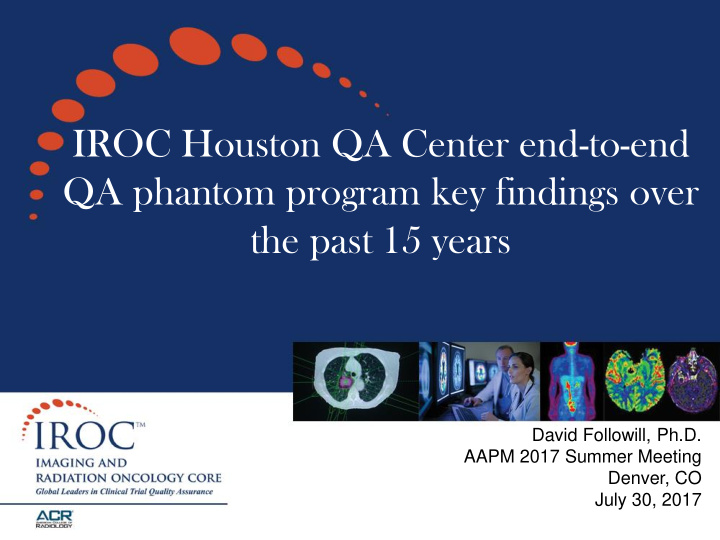



IROC Houston QA Center end-to-end QA phantom program key findings over the past 15 years David Followill, Ph.D. AAPM 2017 Summer Meeting Denver, CO July 30, 2017
Extent Extent of of Acti Activities vities • 1,837 RT facilities participate in NCTN and monitored by IROC Houston • 329 other sites (primarily international also audited • 56 countries monitoring a total of 2166 sites • Largest QA audit program • Shipping >700 phantoms/yr
Imaging, Planning and Delivery - QA required at each step Positioning Image Structure treatment and Acquisition Segmentation planning Immobilization (CT, MR) Black Box File Plan Position treatment transfer and validation verification delivery management
Thus the need for an end-to-end QA audit tool to verify the intended treatment goal. Deliver the correct dose to correct location as planned
Phantom Family 2 prostate phantoms 33 lung phantoms 8 Spine phantoms 10 liver inserts 24 H&N phantoms 19 SRS phantoms
Benefits of IROC-H Phantoms • Anthropomorphic shape with Phantom Patient targets and OARs • Independent “end to end” audit • Imaging • Planning/dose calculation • Setup • delivery • Uniform phantoms and dosimeters Patient Phantom • Standardized analysis • Uniform pass/fail criteria • Allows inst. to inst. comparison • Established infrastructure
Photon Phantom Results Comparison between institution’s plan and delivered dose. Liver Phantom H&N Lung Prostate Spine insert Irradiations 2052 165 1109 566 336 Pass 1755 (86%) 120 (73%) 921 (83%) 484 (86%) 261 (78%) Fail 297 45 188 82 75 Criteria 7%/4mm 7%/4mm 5%/5mm 7%/4mm 5%/3mm
Problems that have been detected
Varian 6 MV IMRT H&N Measurement vs. Monte Carlo Criteria: 3%/2 mm 0 0.2 0.4 0.6 0.8 1 1.2 1.4 1.6 1.8 2.0 L 700 700 680 680 660 660 640 640 Dose Value Dose Value 620 620 L R 600 600 580 580 LATERAL 560 560 P 540 Calc 540 Calc Meas Meas 520 Axial 520 0 10 20 30 40 50 60 70 80 90 0 10 20 30 40 50 60 70 80 90 Distance along line Distance along line 9
Lung Phantom TLD results TLD results Average = 0.967 +/- 2.9% Irradiation Lung Phantom 274 irradiations 1.10 Algorithms included: 1.08 AAA/Superposition/MonteCarlo 1.06 1.04 1.02 RPC/Inst 1.00 0.98 0.96 0.94 0.92 0.90 0 50 100 150 200 250 Irradiation
Lung Phantom TLD results TLD results Average = 0.967 +/- 2.9% Irradiation Lung Phantom 274 irradiations 1.10 Algorithms included: Average = 0.994 +/- 3.3% 1.08 AAA/Superposition/MonteCarlo 30 irradiations Algorithms included: MonteCarlo 1.06 1.04 1.02 RPC/Inst 1.00 0.98 0.96 0.94 0.92 0.90 0 50 100 150 200 250 Irradiation
Lung Phantom Results Percent of pixels passing 5%/3mm gamma criteria Percent of pixels passing ±5%/3mm criteria 96 100 94 90 86 85 80 61 60 52 50 40 31 20 0 Eclipse AAA Pinnacle SC XiO Clarkson TomoTherapy SC MultiPlan PB Eclipse PB XiO SC MultiPlan MC Corvus PB
Proton Phantom Audits • 136 proton phantoms irradiated, analyzed Brain Liver Lung Prostate Spine TOTAL Total Irradiations 25 14 38 38 21 136 # Passed 24 7 24 30 17 102 Pass Rate [%] 96% 50% 63% 79% 81% 75%
Lung Phantom Results
Lung Phantom Results
Lung Phantom Results
Summary • Introduction of new technologies present challenges that need to be verified prior to treating patients • End-to-end QA phantoms detect errors, improve dose delivery accuracy and provide confidence • Improved compliance with protocol prescription specifications and reduced deviation rate
Questions?
Recommend
More recommend